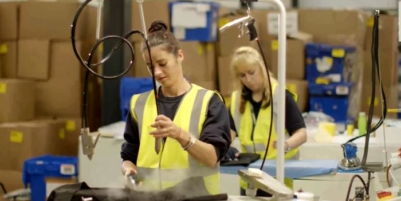-
QUECLINK LAUNCHES COMPACT DMS CAMERA SOLUTION FOR ADVANCED DRIVER MONITORING - 8 hours ago
-
CTRACK AND ARTURA JOIN FORCES TO LAUNCH TELEMATICS-ENABLED ACCIDENT AND REPAIR SOLUTION - April 28, 2025
-
GOPLASTICPALLETS.COM CELEBRATES MONUMENTAL 2,000 TONNE RECYCLING MILESTONE - April 24, 2025
-
LSA INTERNATIONAL CHOOSES PROLOG FULFILMENT TO MANAGE ITS DISTRIBUTION & LOGISTICS - April 23, 2025
-
Uniserve Partners with Logistics Reply to Deliver Transformation to Customers Supply Chains - April 23, 2025
-
Nutrivend selects Forterro’s Orderwise to support online expansion and streamline operations - April 11, 2025
-
ARROWXL LAUNCHES AMBITIOUS ZERO WASTE ROADMAP - April 8, 2025
-
THE BCMPA’S NEW CAMPAIGN DRIVES OUTSOURCING SUCCESS IN Q1 - April 7, 2025
-
BLACKOUT TECHNOLOGIES TARGETS TELEMATICS-INTEGRATED MOBILE DEVICE BLOCKING TO COMBAT SMARTPHONE DISTRACTION - April 1, 2025
-
OpenADR Alliance announces first OpenADR 3.0 certified products with EVoke Systems, E.ON Energy and Universal Devices - March 25, 2025
Robot-based intralogistics systems reduce the pressure on retailers and their supply chain partners during the run up to Christmas and other high profile retail sales events such as Black Friday and China’s Singles Day
The emergence of retail events such as Black Friday and China’s Singles Day (also known as 11.11, because it takes place on November 11th each year) might mean that Christmas is no longer regarded as being as important as it once by many retailers, the volume of online orders created during the run-up to the festive season still puts retail supply chains under intense pressure.
“Processing the spike in order numbers that Christmas as well as the Black Friday and Singles Day events generate stress the performance of a logistics centre. At such times the ability to scale up essential functions such as parcel sortation is essential,” says Xia Hulling, founder, and CEO of LiBiao Robotics, a pioneer of mobile robot-based intralogisitics technology.
Xia Hulling continues: “If online retailers or their 3PL partners have difficulty ramping up warehouse processes to deliver the higher throughput speeds that are required at Christmas time or Black Friday and 11.11 the result is likely to be missed delivery targets and, ultimately, unhappy customers.”
Unfortunately, a lot of logistics hubs and fulfillment centres rely on intralogistics technologies that, in many cases, are neither agile nor speedy. For example, fixed equipment such as tilt-tray or cross-belt conveyors, is now perceived by many systems designers as lacking the flexibility needed to adapt to the often fluid requirements of a modern parcel fulfilment operation.
According to Xia Hulling, when confronted by the twin challenges of high volume and a short delivery cycle, online order fulfilment centres are switching to Autonomous Mobile Robot (AMR) technology.
For example, Nine Clouds is a relatively new e-commerce enterprise based in China. It sells a wide range of snacks and beverages for which a vast number of SKUs (Stock Keeping Units) is required.
The traditional manual sorting method initially used by the company was slow and prone to errors, while inventory management was becoming chaotic and unable to meet the growing demands of the business. So, in May 2023 Nine Clouds deployed the LiBiao Robotics 3D sorting system featuring LiBiao’s Mini Yellow robots within its warehouse. This significantly improved sorting efficiency and accuracy and allowed the company to reduce the number of unskilled workers on site by 35 per cent.
The impact of the LiBiao system on Nine Clouds’ order throughput process was particulalrly apparent during 11:11 when, despite a fivefold increase in order volume, the warehouse was busy but did not descend into chaos as had been the case in earlier years.
“AMR-based parcel sortation systems can be easily scaled up to cope with any spikes in throughput,” Xia explains.
She continues: “Easy to construct and dismantle with no fixed infrastructure requirements, a robotic parcel sorting solution’s capacity is increased by simply introducing additional robots as required. And once the busy period has passed, ‘bots can be removed again just as effortlessly. Furthermore, because the technology is fully portable systems can also be switched between sites if required.”
As well as complete flexibility robotic parcel sorting systems offer other benefits. For example, unlike conveyor-based sorting systems that often have to be completely shut down if a fault develops at any point ‘on the line’, a malfunctioning robot causes no discernible drop in a site’s throughput capacity: the problem unit is simply and quickly removed and replaced meaning the parcel sortation process never stops.
A robot-based sortation system is also highly energy efficient and by resting mobile robotic units during slow periods energy savings are assured. Sortation conveyors however continue to operate throughout a shift regardless of the number of parcels that are being processed. So, at quiet times when only a small number of parcels require sorting, a conveyor uses the same amount of energy as it does during a peak period.
And robotic parcel sortation solutions significantly increase the speed and accuracy of the sorting process and reduce labour costs – which were important considerations for JD.com. JD.com’s facility in the southern region of China is one of the company’s key logistics hubs. It is responsible for delivering goods from local manufacturers and retailers to consumers nationwide.
Since the introduction of a LiBiao intelligent sorting system featuring a fleet of 259 robots, JD has seen a significant reduction in error rates and an impressive increase in overall sorting efficiency at the facility.
Summing up, Xia Hulling says: “AMR technology is reinventing the way that, warehouse tasks such as parcel sortation are performed. And for e-commerce fulfilment centres that are faced with the unique pressures that Christmas and events such as Black Friday and 11.11 bring, robotic sorting systems represent a particularly exciting proposition.”























